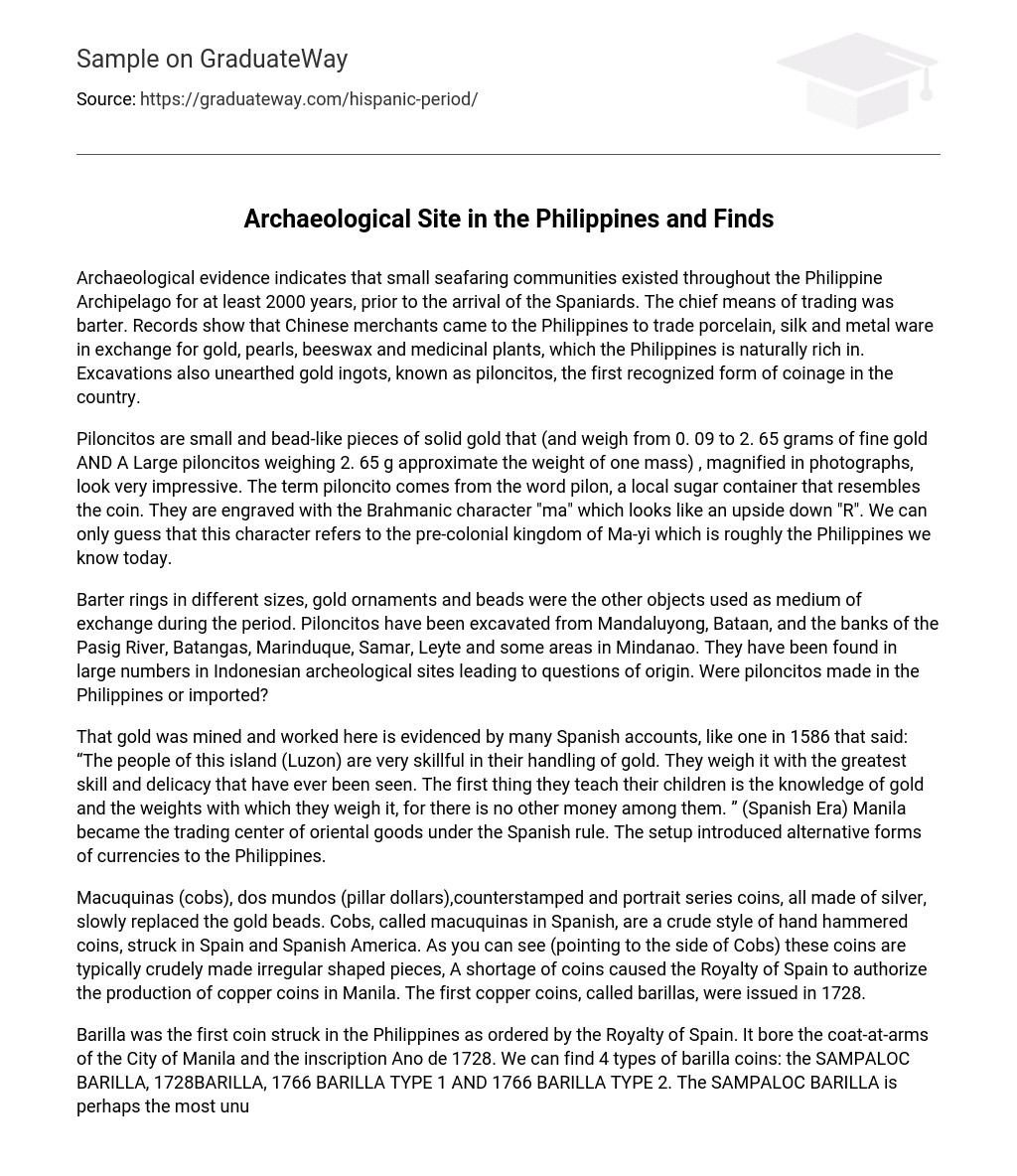Archaeological evidence indicates that small seafaring communities existed throughout the Philippine Archipelago for at least 2000 years, prior to the arrival of the Spaniards. The chief means of trading was barter. Records show that Chinese merchants came to the Philippines to trade porcelain, silk and metal ware in exchange for gold, pearls, beeswax and medicinal plants, which the Philippines is naturally rich in. Excavations also unearthed gold ingots, known as piloncitos, the first recognized form of coinage in the country.
Piloncitos are small and bead-like pieces of solid gold that (and weigh from 0. 09 to 2. 65 grams of fine gold AND A Large piloncitos weighing 2. 65 g approximate the weight of one mass) , magnified in photographs, look very impressive. The term piloncito comes from the word pilon, a local sugar container that resembles the coin. They are engraved with the Brahmanic character “ma” which looks like an upside down “R”. We can only guess that this character refers to the pre-colonial kingdom of Ma-yi which is roughly the Philippines we know today.
Barter rings in different sizes, gold ornaments and beads were the other objects used as medium of exchange during the period. Piloncitos have been excavated from Mandaluyong, Bataan, and the banks of the Pasig River, Batangas, Marinduque, Samar, Leyte and some areas in Mindanao. They have been found in large numbers in Indonesian archeological sites leading to questions of origin. Were piloncitos made in the Philippines or imported?
That gold was mined and worked here is evidenced by many Spanish accounts, like one in 1586 that said: “The people of this island (Luzon) are very skillful in their handling of gold. They weigh it with the greatest skill and delicacy that have ever been seen. The first thing they teach their children is the knowledge of gold and the weights with which they weigh it, for there is no other money among them. ” (Spanish Era) Manila became the trading center of oriental goods under the Spanish rule. The setup introduced alternative forms of currencies to the Philippines.
Macuquinas (cobs), dos mundos (pillar dollars),counterstamped and portrait series coins, all made of silver, slowly replaced the gold beads. Cobs, called macuquinas in Spanish, are a crude style of hand hammered coins, struck in Spain and Spanish America. As you can see (pointing to the side of Cobs) these coins are typically crudely made irregular shaped pieces, A shortage of coins caused the Royalty of Spain to authorize the production of copper coins in Manila. The first copper coins, called barillas, were issued in 1728.
Barilla was the first coin struck in the Philippines as ordered by the Royalty of Spain. It bore the coat-at-arms of the City of Manila and the inscription Ano de 1728. We can find 4 types of barilla coins: the SAMPALOC BARILLA, 1728BARILLA, 1766 BARILLA TYPE 1 AND 1766 BARILLA TYPE 2. The SAMPALOC BARILLA is perhaps the most unusual coin of the Philippines in terms of shape. It is cast in lead and is one of the rarest among the barillas. SAMPALOC BARILLAS first appeared when it was excavated during a river widening project in the province of Laguna.
Only about 2 to 3 specimen are believed to have been found. 1728 BARILLA: Cast uniface barilla with arms of Manila stamped in center. VERY RARE. According to the Central Bank of the Philippines Quarterly Vol. II #1, this type was unknown until 1948 when the first specimen was found in the ruins of an old building in Sto. Tomas. Carlos III Copper Barilla 176: the Obverse shows a Castle within circle, date below; the Reverse showsCrowned ornate shield divides value. Obv: CIUDAD DE MAN . 1766. round outer edge. At the top is a crown with a castle below. Rev: Within a wide crowned shield is a sea-lion holding a sword. The shield divides a “BA monogram and the figure “1” (value). 1766 BARILLA TYPE IIappears to be well-struck compared to the Type I Barilla with the tail of the Merlion swaying on the left side rather on the right side of the 1766 Barilla Type I. The “castle tower” of the 1766 Barilla Type I have a raised left side veranda compared to the uniform “castle tower” of the Barilla Type II.





